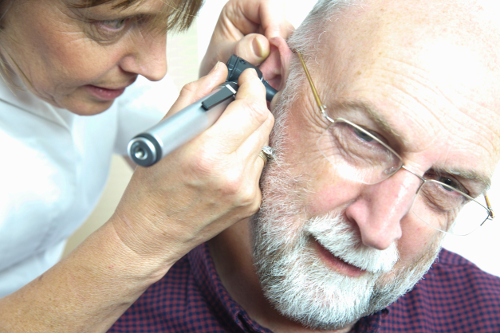 Any problems affecting your ear, particularly the inside of the ear, can call for immediate attention. A cholesteatoma is a cyst that develops in the middle ear that, if left untreated, can lead to facial paralysis and quite possibly a brain abscess. We will look at cholesteatoma causes and the only treatment available for this serious condition.
Any problems affecting your ear, particularly the inside of the ear, can call for immediate attention. A cholesteatoma is a cyst that develops in the middle ear that, if left untreated, can lead to facial paralysis and quite possibly a brain abscess. We will look at cholesteatoma causes and the only treatment available for this serious condition.
The cholesteatoma is basically a collection of skin cells in the middle ear that should not be there. Also known as a keratoma, this skin cyst can grow and release enzymes that destroy the eardrum, the bones of the ear and the skull, as well as facial nerves. Cholesteatoma complications include inner ear swelling, infections of the ear and the brain, and permanent hearing loss.
Causes and Symptoms of Cholesteatoma
Cholesteatoma causes will depend upon whether the skin growth is present at birth or acquired later in life. Cholesteatoma symptoms may include hearing loss, discharge, pressure, or a punctured eardrum. In young children, additional symptoms may be fever, balance difficulties, or ear pain.
1. Congenital Cholesteatoma
During development in the womb, squamous epithelial (skin layer) cells form a cholesteatoma in the middle ear. Because the eardrum is not punctured, there is no ear discharge; and the only symptom may be hearing loss as the cyst blocks the Eustachian tube and interrupts the growth of the ossicles. This form can go undetected until the child is between the ages of six months and five years.
2. Acquired Cholesteatoma
When a cholesteatoma develops later in life, we can attribute the cause to two types: primary and secondary. Primary acquired cholesteatoma is linked to bouts of sinusitis and rhinitis, both from infection and allergies. A middle ear infection (otitis media) can also cause this form of cholesteatoma. All of these conditions cause inflammation of the Eustachian tube, which results in unequalized air pressure. This imbalance can create a “vacuum” that sucks epithelial cells and the eardrum into the middle ear, forming a cholesteatoma.
Secondary acquired cholesteatoma develops from a ruptured eardrum, which may have occurred due to an injury to the ear or head, otitis media, placement of ear tubes, or as a result of surgery. From these conditions, epithelial cells form a cholesteatoma in the middle ear.
Diagnosing and Treating Cholesteatoma
Early detection of cholesteatoma is very important as it may help prevent further complications. You should consult with a medical professional as soon as possible. You can expect to have your ears examined for signs of a blood vessel mass or a skin cell mass. Your medical history will be discussed and a hearing test may be performed. With symptoms of facial weakness and dizziness and no visible signs of a mass, you may have a computerized tomography (CT) scan. The CT scan will allow better visibility inside your ear and skull.
1. Treatment Options
Once you receive a diagnosis, cholesteatoma treatment should start immediately to avoid further damage from the growing cyst. The only treatment available is surgery to remove the cholesteatoma. Before the procedure, you may need to have the ear cleaned out and drained. If infected, you may be prescribed antibiotics to reduce inflammation.
After surgery to remove the cholesteatoma, you may require additional surgical procedures to repair any damage. If the cholesteatoma cannot be removed as a whole, any remaining pieces may form another cyst that will need to be removed at a later time. Any eardrum ruptures are repaired with a tympanoplasty procedure.
Another possible procedure is a tympanomastoidectomy, which involves removal of affected tissue and restoration within the mastoid, the bony area behind the ear. The eardrum can then be repaired. This procedure is also seen with patients who have had recurring ear infections. It is done in two ways, canal-wall-down or canal-wall-up.
After the cholesteatoma surgery, you may want to have regular checkups to ensure another cholesteatoma has not formed.
Cholesteatomas are Serious
Cholesteatoma refers to a skin cyst that forms in the middle ear. While it presents no pain, it can lead to profound consequences if left untreated. Cholesteatoma complications may include facial paralysis, brain abscess, or hearing loss. There is no quick fixes or natural remedies for such a mass as surgical removal is the only treatment. Of the two types of cholesteatomas, congenital forms cannot be prevented but can be treated before severe damage is done—if detected early. Cholesteatomas that form later in life may be prevented with early treatment of ear infections.
Also Read:
Rash Behind the Ear: 5 Causes and Treatments
Sources:
Dr. Chris, “Cholesteatoma Meaning, Symptoms, Recurrence, Surgery, Video,” Health Hype; http://www.healthhype.com/cholesteatoma-meaning-symptoms-recurrence-surgery-video.html, last accessed April 6, 2017.
“Cholesteatoma,” Healthline; http://www.healthline.com/health/cholesteatoma#overview1, last accessed April 6, 2017.
“Cholesteatoma”, American Academy of Otolaryngology – Head and Neck Surgery; http://www.entnet.org/content/cholesteatoma, last accessed April 6, 2017.
“Cholesteatoma,” Medline Plus; https://medlineplus.gov/ency/article/001050.htm, last accessed April 6, 2017.
“Cholesteatoma,” Mount Sinai Hospital; http://www.mountsinai.org/patient-care/service-areas/ent/areas-of-care/hearing-and-balance/cholesteatoma, last accessed April 6, 2017.
